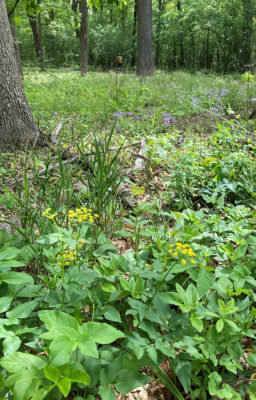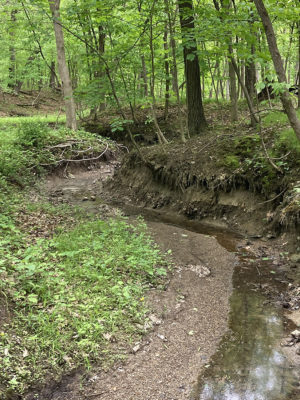In the fall of 2022, the Forest Preserves is starting a major ecological and hydrological restoration project to restore land and water within Forest Preserves property adjacent to Tinley Creek at Camp Sullivan. This landscape was identified as a high priority in the Forest Preserves’ Natural and Cultural Resources Master Plan.
On this page:
Background
The project will have two main components:
- On-the-ground ecological restoration of 180 acres of floodplain and associated upland areas at Camp Sullivan.
- Hydrologic restoration in the Tinley Creek watershed, including comprehensive planning to identify hydrologic impairments and solutions as well as implementing best management practices.
Ecological and hydrologic restoration creates healthy preserves that provide natural infiltration of rainwater to reduce flooding and soil erosion. In its current condition, portions of Camp Sullivan and other preserves in the Tinley Creek landscape are dominated by invasive brush and dense trees that create deep shade and bare soil that is suspectable to erosion. This erosion compounds over time creating in-stream sedimentation, channelization, downcutting and disconnection of Tinley Creek and its tributaries to their floodplains. As invasive brush and trees are removed, sunlight reaches the ground layer and vegetation flourishes. Ground layer vegetation intercepts rainwater and holds soil, reducing soil erosion and providing a filtering effect.

Many degraded areas can be restored through invasive species removal alone, but in some instances, targeted and more intensive repairs such as stream bank stabilization or re-meandering are required to repair natural hydrology. This project will also identify and implement targeted hydrologic repairs.
Healthy, restored lands provide open access to the residents of Cook County, including a more enjoyable and accessible user experience. Visitors to restored lands experience unobstructed vistas, a greater diversity of plants and animals, and opportunities to participate in outdoor recreational activities, which can have a positive impact on people’s mental and physical health.
Tinley Creek is a 9.49-mile stream that drains approximately 12.9 square miles from its headwaters in Orland Hills to its discharge into the Cal-Sag Channel in Crestwood. Tinley Creek is a tributary of the Cal-Sag Channel and is included in Calumet-Saganashkee Watershed Plan (2017).

Currently, the Illinois Environmental Protection Agency lists Tinley Creek as an impaired stream for aquatic life. The Forest Preserves owns and manages a significant portion of the lands within the Tinley Creek watershed (about 40%). As a major landowner, the ecological health and condition of Forest Preserve lands impact the water quality of Tinley Creek. The Forest Preserves is in the process of restoring natural areas within its holdings through invasive species removal, prescribed fires and native seeding. These activities will increase native ground layer vegetation which will improve water infiltration and decrease sedimentation into Tinley Creek. In 2022, the Forest Preserves completed a number of restoration activities for the Tinley Creek Ravines Restoration Project at Catalina Grove in the Tinley Creek Watershed. The project at Camp Sullivan will build upon and expand the restored portion of the watershed.
Restoration Work
The Forest Preserves’ Resource Management Department is coordinating and managing this project. Under their direction, contractors will be thinning unnaturally dense native trees and removing invasive tree and brush species from approximately 400 acres of woodland and floodplain forest. This work will restore a diverse ground layer of plants, enhance native wildlife habitat, reduce erosion and allow the soil to absorb more stormwater.
Forest Preserves staff and contractors will conduct follow-up vegetative and woody invasive species control during growing seasons. The Forest Preserves will also address areas of excessive erosion through hydrologic repairs in 2023 and 2024. The restoration work is scheduled to start in the fall of 2022 and continue through 2026.
Funding
Funding is provided by the Cook County Department of Environment and Sustainability with dollars from the American Rescue Plan Act (ARPA). These funds are also funding a similar project along Thorn Creek in the Sauk Lake landscape. The projects further the mission of Cook County and the Forest Preserves and serves the broader ARPA objectives of protecting the health, safety and welfare of county residents through flood reduction and improved air and water quality.

